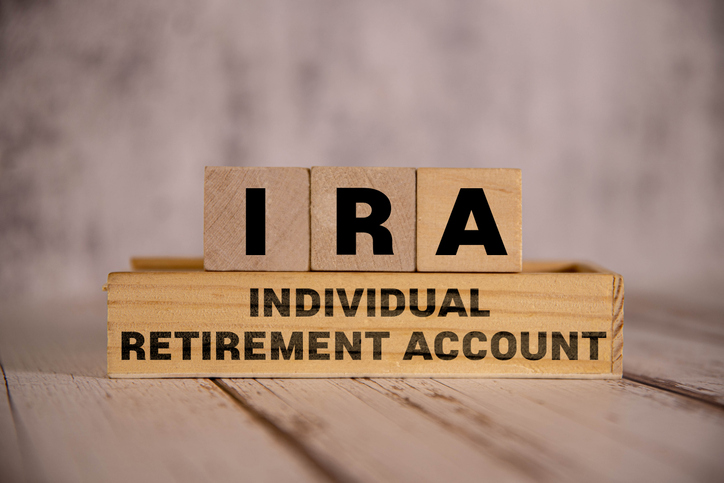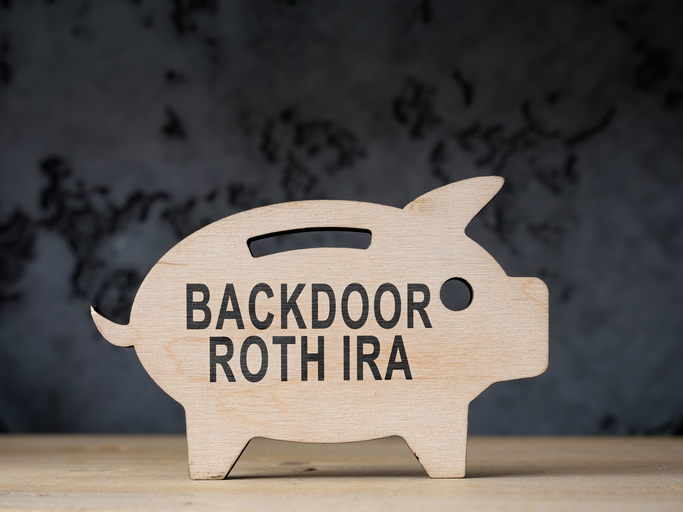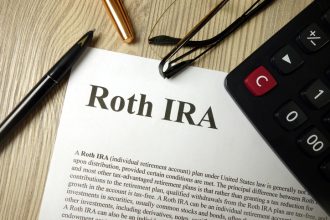High earners often weigh the mega backdoor Roth against the backdoor Roth to expand tax-free growth. A backdoor Roth works by making a nondeductible traditional IRA contribution and then converting it to a Roth. A mega backdoor Roth, on the other hand, uses after-tax 401(k) contributions that are later converted in-plan or rolled to a Roth IRA. Both can add long-term tax flexibility, but they differ in contribution limits, eligibility rules, plan availability and administrative steps.
If you’re deciding between a mega backdoor Roth and a backdoor Roth, a financial advisor can help you compare these strategies for your retirement portfolio.
What Is a Backdoor Roth IRA?
A backdoor Roth IRA is a retirement strategy workaround that is used by individuals whose income exceeds the limit for direct Roth IRA contributions. It works by combining a traditional IRA contribution with a Roth conversion, giving high earners another way to build tax-free retirement savings.
The process starts with a nondeductible contribution to a traditional IRA, followed by converting that amount into a Roth IRA. The transaction is reported on IRS Form 8606 to track after-tax basis. Once in the Roth IRA, funds grow tax-free, and qualified withdrawals in retirement are not subject to federal income tax.
The pro-rata rule affects how much of the conversion is taxable. The IRS combines all traditional, SEP and SIMPLE IRA balances when calculating the taxable portion. If you hold pre-tax assets in these accounts, part of the conversion may generate a tax liability.
Some investors address this by moving pre-tax IRA balances into an employer 401(k), which is not included in the pro-rata calculation. This step leaves only the after-tax contribution for conversion, making the backdoor Roth a more practical way to expand long-term tax flexibility.
How a Backdoor Roth Works
If you are considering a backdoor Roth, here are three steps to help you get started:
- Start by confirming IRA account setup and your existing IRA balances.
- Make a nondeductible contribution to a traditional IRA, let the funds settle, then convert to a Roth IRA via a trustee-to-trustee movement. If a small pre-conversion gain appears, that portion is taxable. If a small loss appears, you convert the lower value.
- File Form 8606 to document basis and the conversion amount.
Savers often perform the contribution and conversion close together to limit taxable earnings. If you already hold large pre-tax IRA balances, one way to avoid the pro-rata rule in a backdoor Roth or mega backdoor Roth strategy is to roll those pre-tax funds into an employer-sponsored retirement plan first. That step can keep your Roth conversion amount clean and prevent unexpected tax liabilities.
For 2025, the IRA contribution limit is $7,000, or $8,000 if you are age 50 or older. This total applies across all your IRAs—traditional and Roth combined.
Benefits and Limits of the Backdoor Roth
One main benefit of the backdoor Roth is that it gives high earners a way to keep adding money to a Roth IRA when income limits block direct contributions. Used year after year, this strategy can help you build a tax-free pool that could support retirement spending.
The long-term upside is significant. Roth IRAs grow tax-free, qualified withdrawals are not taxed and no required minimum distributions (RMDs) apply during the original owner’s lifetime. This can allow retirees to manage tax brackets more effectively, control cash flow in retirement and leave Roth assets to heirs without forcing taxable withdrawals.
Drawbacks include the low annual contribution cap, which limits how much you can save with this strategy. The pro-rata rule can increase the taxable portion of a conversion for those with large pre-tax IRA balances, sometimes requiring a rollover into a 401(k) to isolate after-tax dollars before converting.
Compliance is also required. The IRS mandates Form 8606 each year to document contributions and conversions, and completing the conversion shortly after the contribution can limit taxable earnings. These requirements make the backdoor Roth more suitable for retirement savers who have already maximized other qualified accounts and intend to increase tax-free growth.
What Is a Mega Backdoor Roth?

A mega backdoor Roth is done through a 401(k). After making the maximum regular salary deferrals, some plans allow additional after-tax contributions up to the annual additions limit. Those after-tax dollars can then be moved to Roth, either by converting them inside the 401(k) or rolling them to a Roth IRA. This approach allows much larger Roth contributions in a single year than the standard backdoor Roth.
Your ability to use this strategy will depend on the plan. The 401(k) must accept after-tax contributions beyond regular deferrals, and it must also permit either in-plan Roth conversions or in-service rollovers. Without these features, the strategy cannot be used.
For savers who have access, the mega backdoor Roth can accelerate the growth of tax-free assets. It allows far greater Roth funding than annual IRA limits, making it useful for those who are already contributing the maximum to regular retirement accounts and still want to move more savings into a Roth.
How a Mega Backdoor Roth Works
If you are considering a mega backdoor Roth, here are four steps to help you get started:
- Confirm your plan permits after-tax employee contributions and either in-plan Roth conversions or in-service rollovers.
- Fund after-tax dollars through payroll, then convert them periodically to Roth 401(k) or distribute to a Roth IRA, keeping frequency high enough to minimize pre-conversion earnings. Some plans even automate the conversion step, which can keep taxable growth near zero.
- Coordinate with HR on match formulas and the annual additions limit so after-tax funding does not crowd out employer contributions.
- Track your conversions and 1099-R forms for tax time, and keep statements that show the flow of after-tax dollars into Roth.
For 2025, employee elective deferrals (pre-tax or Roth) are capped at $23,500, with catch-up contributions of $7,500 for people aged 50–59 or 64 and up, and $11,250 for ages 60–63. The total annual contributions (including employer match and after-tax) cannot exceed $70,000 for 2025.
Benefits and Limits of the Mega Backdoor Roth
One of the main benefits of using a mega backdoor Roth is the ability to move far more into Roth accounts than an IRA allows. After-tax 401(k) contributions can be converted to Roth, sometimes reaching tens of thousands of dollars in a single year.
Because these contributions are made inside the 401(k), the IRA pro-rata rule does not apply. The conversion is simpler to report and avoids the complications that arise with mixed pre-tax and after-tax IRA balances.
The key limitation is plan design. The 401(k) must permit after-tax contributions and either in-plan Roth conversions or in-service rollovers. Plans that lack these features prevent the strategy, and highly compensated employees may also face contribution testing limits.
Administration adds another constraint. Savers must monitor the annual additions limit, coordinate contributions with employer match formulas, and maintain records such as Form 1099-R to document conversions accurately.
Mega Backdoor Roth vs. Backdoor Roth: Key Differences
Capacity is the biggest difference between both strategies. A backdoor Roth only converts the year’s IRA contribution. The mega backdoor Roth, by comparison, can move much larger after-tax 401(k) contributions into Roth accounts, up to the plan’s annual additions cap. For those aiming to maximize Roth savings each year, the mega option provides far greater scale.
Administration is another dividing line. The backdoor Roth uses Form 8606 and is affected by the pro-rata rule if pre-tax IRA balances exist. The mega backdoor Roth requires Form 1099-R, affects employer match formulas, and depends on specific plan features. These components can make the process more complex.
Access is also different. Anyone with earned income can establish a backdoor Roth through an IRA, while the mega backdoor Roth requires a 401(k) plan that allows after-tax contributions and Roth conversions. If the plan does not offer these features, the strategy cannot be used.
Complexity is another key difference. The backdoor Roth is relatively straightforward once established, while the mega backdoor Roth requires more attention to payroll deductions, contribution limits and HR coordination. Both create Roth dollars, but the effort and oversight needed are not the same.
Frequently Asked Questions Regarding Mega Backdoor Roth vs. Backdoor Roth
Does the pro-rata rule apply to a mega backdoor Roth?
Not to the after-tax 401(k) source. The pro-rata rule applies to IRA conversions and aggregates traditional, SEP and SIMPLE IRA balances.
Will after-tax 401(k) contributions affect my match?
Employer matching is usually based on elective deferrals, not after-tax contributions, but plan formulas vary. Confirm how your plan calculates the match and how the annual additions limit interacts with it.
How often should I convert after-tax 401(k) dollars?
More frequent conversions generally reduce taxable earnings on the after-tax source. Some plans offer automatic ongoing conversions, while others allow periodic, on-demand moves.
Can I do a backdoor Roth and a mega backdoor Roth in the same year?
Yes, subject to your plan and cash-flow capacity. Using both can maximize Roth accumulation within the mega backdoor Roth vs backdoor Roth framework.
Do five-year clocks work the same for Roth IRA and Roth 401(k)?
Bottom Line

High earners can use a backdoor Roth or a mega backdoor Roth to build tax-free retirement savings. A backdoor Roth is limited to the yearly IRA contribution and requires Form 8606 to report the conversion. The mega backdoor Roth depends on 401(k) plan rules and can move much larger after-tax contributions into Roth accounts, reported on Form 1099-R. Both strategies create long-term tax benefits, but they differ in how much you can contribute, who can use them and the steps involved.
Retirement Planning Tips
- If you need help deciding between the mega backdoor Roth and a backdoor Roth strategy, a financial advisor can help review each option for your retirement plan. SmartAsset’s free tool matches you with vetted financial advisors who serve your area, and you can have a free introductory call with your advisor matches to decide which one you feel is right for you. If you’re ready to find an advisor who can help you achieve your financial goals, get started now.
- SmartAsset’s Social Security calculator can help you estimate future monthly government benefits.
Photo credit: ©iStock.com/designer491, ©iStock.com/Ridofranz, ©iStock.com/Zolak
Read the full article here














